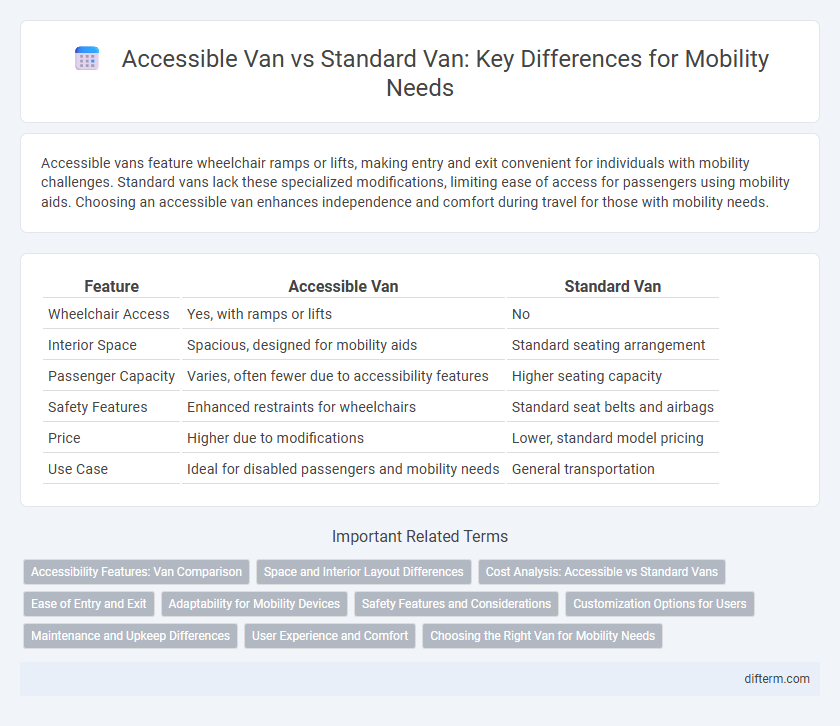Accessible vans feature wheelchair ramps or lifts, making entry and exit convenient for individuals with mobility challenges. Standard vans lack these specialized modifications, limiting ease of access for passengers using mobility aids. Choosing an accessible van enhances independence and comfort during travel for those with mobility needs.
Table of Comparison
| Feature | Accessible Van | Standard Van |
|---|---|---|
| Wheelchair Access | Yes, with ramps or lifts | No |
| Interior Space | Spacious, designed for mobility aids | Standard seating arrangement |
| Passenger Capacity | Varies, often fewer due to accessibility features | Higher seating capacity |
| Safety Features | Enhanced restraints for wheelchairs | Standard seat belts and airbags |
| Price | Higher due to modifications | Lower, standard model pricing |
| Use Case | Ideal for disabled passengers and mobility needs | General transportation |
Accessibility Features: Van Comparison
Accessible vans are equipped with specialized features such as wheelchair ramps, lowered floors, and securement systems, enhancing ease of entry and safety for passengers with mobility challenges. Standard vans typically lack these modifications, offering limited assistance for wheelchair users or individuals with disabilities. The presence of adaptive technology in accessible vans ensures compliance with ADA standards while promoting independent travel.
Space and Interior Layout Differences
Accessible vans prioritize spacious interiors with widened doorways and lower floors to accommodate wheelchair users, offering ample room for easy maneuverability and securement systems. Standard vans typically have conventional seating arrangements with less headroom and narrower aisles, limiting accessibility and interior flexibility. The interior layout of accessible vans is optimized for customized seating, ramps, and storage solutions, enhancing comfort and functionality for passengers with mobility challenges.
Cost Analysis: Accessible vs Standard Vans
Accessible vans typically incur higher upfront costs than standard vans due to specialized modifications such as ramps, lifts, and widened doors that enhance mobility for individuals with disabilities. Maintenance and repair expenses can also be elevated, reflecting the complexity of adaptive equipment and increased wear from frequent use. However, accessible vans may offer cost efficiencies in transportation services by reducing the need for external assistance and improving passenger independence.
Ease of Entry and Exit
Accessible vans feature widened doors, low floors, and ramps or lifts that simplify entry and exit for individuals using wheelchairs or mobility aids, significantly reducing physical strain. Standard vans typically have higher steps and narrower doorways, which can pose challenges for those with limited mobility. The design enhancements in accessible vans prioritize user convenience and safety, making them more suitable for passengers requiring assistance.
Adaptability for Mobility Devices
Accessible vans feature built-in ramps or lifts, wider doorways, and lower floors designed specifically for wheelchair compatibility, whereas standard vans require aftermarket modifications to accommodate mobility devices. These customizations allow accessible vans to provide seamless entry and securement for wheelchairs and scooters, ensuring safer and more convenient transportation. Adaptability of accessible vans supports diverse mobility devices without compromising interior space, unlike standard vans that may limit ease of use and flexibility.
Safety Features and Considerations
Accessible vans specialize in safety features such as wheelchair restraints, low floors, and ramps designed to secure passengers with mobility devices, reducing the risk of injury during transit. Standard vans generally include basic safety elements like airbags and seat belts but lack modifications for efficient boarding, disembarking, and securing mobility aids. Choosing between an accessible van and a standard model involves assessing the necessity of customized safety measures that address the unique needs of passengers with disabilities.
Customization Options for Users
Accessible vans offer extensive customization options such as wheelchair lifts, ramps, and specialized seating configurations tailored to individual mobility needs, unlike standard vans which typically feature fixed seating and limited modifications. Users benefit from adaptive controls, lowered floors, and securement systems in accessible vans to enhance safety and independence. These customizations significantly improve accessibility and comfort for people with disabilities, making accessible vans a superior choice for personalized transportation solutions.
Maintenance and Upkeep Differences
Accessible vans typically require specialized maintenance for wheelchair lifts, ramps, and reinforced flooring, which can increase upkeep costs compared to standard vans. Standard vans have conventional mechanical systems and fewer modifications, resulting in generally lower maintenance complexity and expenses. Regular inspections of accessibility features are crucial to ensure safety and functionality, adding to the overall maintenance routine of accessible vans.
User Experience and Comfort
Accessible vans offer enhanced user experience by featuring low floors, ramps, and spacious interiors designed to accommodate wheelchairs, providing greater ease of entry and exit compared to standard vans. These modifications improve comfort through adjustable seating, ample headroom, and secure anchorage systems that ensure safety and stability during transit. In contrast, standard vans often lack these specialized features, potentially limiting accessibility and overall comfort for users with mobility challenges.
Choosing the Right Van for Mobility Needs
Accessible vans offer specialized features such as wheelchair ramps, lowered floors, and securement systems that enhance mobility and independence for individuals with disabilities. Standard vans, while more affordable and versatile for general use, lack customized adaptations that support safe and comfortable transport for wheelchair users. Selecting the right van depends on assessing specific mobility requirements, vehicle size preferences, and budget constraints to ensure accessibility and ease of use.
Accessible van vs Standard van Infographic

 difterm.com
difterm.com